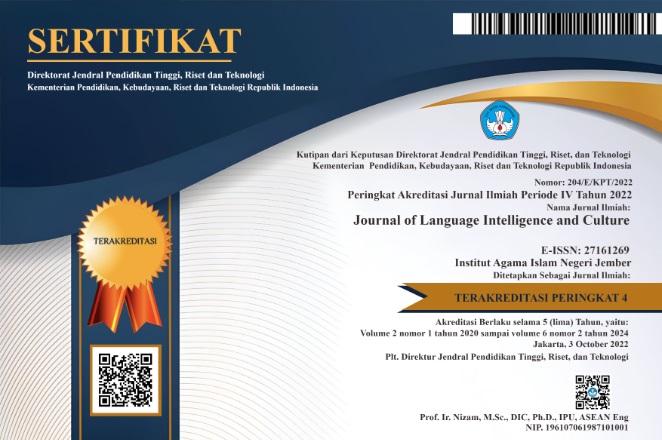Correlation between Beliefs on Translation and the Use of It as an English Learning Strategy
DOI:
https://doi.org/10.35719/jlic.v2i1.21Keywords:
Translation as a Learning Strategy, Students’ Beliefs, The Use of TranslationAbstract
This current study focuses its investigation on the correlation between students’ beliefs about the use of translation as an English learning strategy and the strategic use of translation in learning English by EFL students in Indonesia. This current study is aimed 1) to investigate the correlation between students’ beliefs and the use of translation as a learning strategy 2) to examine the developmental of the use of translation as a learning strategy across different year of study. One hundred seventeen undergraduate students, consisting 67 freshmen and 50 sophomores participated in this correlational study. The data were collected by frequency of an Indonesian Version of the Inventory for Beliefs about Translation for beliefs measurement and the Inventory for Translation as a Learning Strategy. Correlation and t-test were employed in the study. Correlation analysis reveals that a strong positive correlation between students’ beliefs about translation and their use of translation as learning strategy. T-test finds the significant difference in the use of translation as learning strategy between freshman and sophomore learner.
References
Al-Musawi , N. M. ( 2003 ). The effect of student teaching programs in the College of Education at the University of Bahrain on students' beliefs about teaching and learning processes. Kingdom of Bahrain: Univer. Of Bahrain Press.
Aktein & Gliniecki (2015).ELTsStudents’ beliefs about and strategy use of translation. International Online Journal of Education and Teaching (IOJET), 2(1). 12-24.
Brooks, L.,& Kimberly A. (2009). Adult learners’ perceptions of the incorporation of their L1 in foreign language teaching and learning. Applied Linguistics 30(2), 216-235.
Chia, H.L., and H.U. Chia.(2001) ‘English reading concepts held by Taiwanese EFL readers’, English Teaching & Learning, 26(2), 23-44.
Husain, L. 1995 ‘Assessing the role of translation as a learning strategy in ESL’, International Journal of Translation, 1(2), 59- 84.
Karimian, Z. (2013). Students’ use of translation as a learning strategy in EFL classroom. Journal of Language Teaching and Research, Vol. 4(3), 605-610
Kavaliauskienë , G. , & Kaminskienë , L. ( 2007 ) The effect of individual differences on learners' translation beliefs in EFL learning. Kalbotyra , 57 (3) 132 - 139 .
Liao, P. S. (2006). EFL learners’ beliefs about and strategy use of
translation in English learning, RELC Journal, 37(2), 191-215 O'Malley , J. M. , Chamot , A. U. , Stewner. M , G. , Kupper ,L. , and
Russo , R. P. ( 1985 ) Learning strategy applications with students of English as a second language . TESOL Quarterly,19 , 557 - 584 .
Prince , P. ( 1996 ) Second language vocabulary learning: the roleof context versus translation as a function of proficiency . The Modern Language Journal, 80 , 478 - 493 .
Wenden, A. (1987). How to Be a Successful Language Learner: Insights and Prescriptions from L2 Learners’, in A.L.
Wenden and J. Rubin (eds.), Learner Strategies in Language Learning (Englewood Cliffs, NJ: Prentice-Hall): 103-18.
Downloads
Published
How to Cite
Issue
Section
License
Copyright (c) 2020 Journal of Language Intelligence and Culture

This work is licensed under a Creative Commons Attribution-ShareAlike 4.0 International License.













